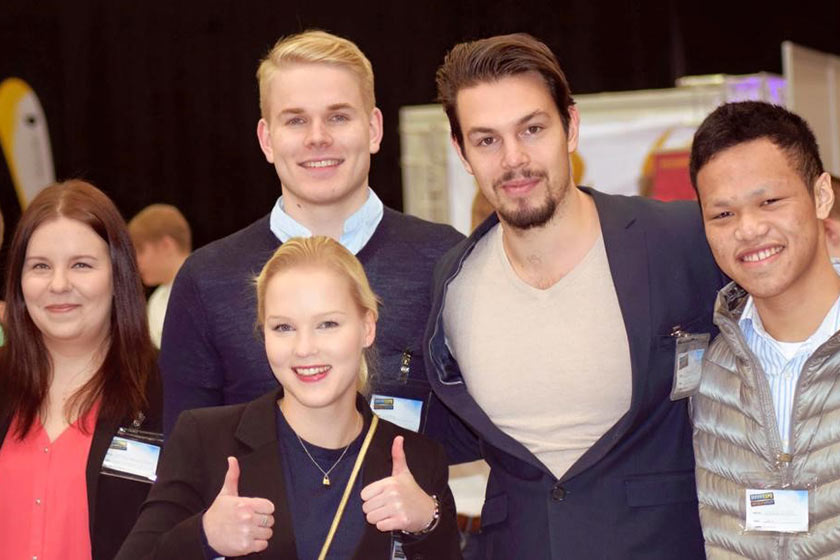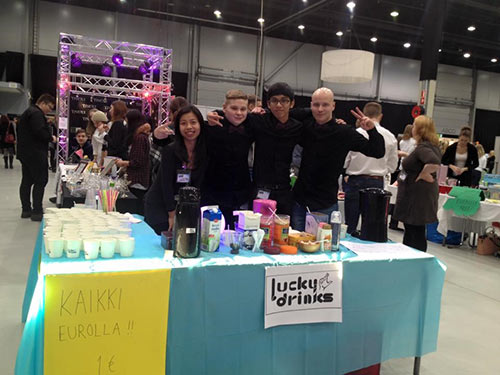
Introduction
The purpose of the paper is to introduce the experimental Mission Possible pilot project, a student integration through involvement model at Lahti University of Applied Sciences (Lahti UAS). It was carried out in January 2016 by incoming International Trade Degree Programme (KVK) and International Business Degree Programme (IBU) students as their orientation week program. Instead of traditional day-long information lectures lasting for one week, the newbie students were put to work on their first group project already on the third day of the start of their studies. The project involved setting up and running a new venture. The results of this model provide strong support for using it in the future and perhaps with groups of newbie students in other university of applied sciences, too.
Mission Possible – the Idea
The Mission Possible pilot project was implemented to encourage student integration through involvement, in a practical sense. The idea of the project was to have the students to experience actual business operations right from the word go – thus, giving them an opportunity to experience real-life business in practice. The project aimed to help students, coming from two different degree programs and from different countries, to become acquainted with each other, to encourage social networking between the students in order to help them develop a closer connection to each other, and to support the integration of these students into their business studies. In addition, the students would learn team work skills, working in a multicultural environment, and learn the basics of start-up development.
The KVK and IBU students were expected to complete their project so as to be ready for the one-day DuuniExpo Networking and Career Fair, held in Lahti, on January 20, 2016. After preparatory lectures facilitated by the authors of the paper, the students had exactly one week’s time to plan, prepare, and implement their project.
DuuniExpo is a yearly-held fair that gathers students of all faculties at Lahti UAS and recruiters of the Lahti region together. Attendance at the fair differs from one year to the next with average attendance being 5,000 people. DuuniExpo – created, organized, and implemented by Lahti University of Applied Sciences’ students – is open to everyone. (DuuniExpo 2016.)
Mission Possible Practicalities
The project began with the presentation of the Mission Possible pilot project idea and the implementation phases of the project to the students. This was followed by lectures in business model principles (Osterwalder & Pigneur 2013), teamwork and team working and culture-related practices (Hofstede & Hofstede & Minkov 2010, Loughborough University 2016, Tuckman 1965). The sixty-nine students were divided into ten groups of six to eight students per group. Each group had both Finnish and foreign students. This ensured that all students became acquainted with each other as well as with each other’s cultures.
After getting to know each other via group discussion, based on pre-arranged discussion questions, the students then went on to brainstorm what product or service they would create and sell at the DuuniExpo Fair. The product or service could be anything legally approved of – either tangible or intangible. The idea of the chosen product or service was presented to the rest of the class the following day, thus avoiding overlapping of product or service ideas. There were four check points all-in-all ensuring the progression of the project and development of the business ideas. The final check point was the feedback-for-the-project check point.
Each group was given 50 euros as their budget to cover the expenses incurred in the implementation of their product or service. After the DuuniExpo event, the groups were required to pay the 50 euros back. Any profit they attained from their sales they were allowed to keep and divide amongst their group members. Results of each group’s earnings were presented the day after the DuuniExpo Fair. The group earning the most profit was declared the winning team and received their prizes.
The groups, besides working on creating their actual product or service, were also responsible for setting up and clearing their stands at the fair, arranging transportation of their products/equipment to and from the DuuniExpo, managing their cash flow, marketing/advertising their stand/products/service, and arranging the day schedule, time-wise, for each group member.
The ten groups came up with the following products and services: homemade muffins, cake, hot dogs, candy; hot and cold beverages; circulating coffee cart; handmade backpack bags, cell phone covers, candles and postcards; picture-taking booth; discount and offer coupons and raffle tickets.

Even though the prices of the products or services were quite cheap, the students earned, in total, a profit of 1,778 euros. The winning group sold raffle tickets – where each raffle ticket buyer won a prize donated by local businesses. The winning group donated their 468-euro profit to a charity cause.
Students’ Experience
Feedback for the Mission Possible project was collected by the two project facilitators after the DuuniExpo Fair. Feedback was collected with feedback forms. The forms were handed-out to the students and collected after completion at the beginning of the final day of the project, before the winning team/award was announced. Of the 69 students, fifty-five (79.7%) submitted a completed feedback form. The results were analyzed using Excel to find common themes. According to the feedback, all the students were extremely satisfied with the Mission Possible project. Also, they expressed how exciting and educative it was to really learn what the business concept means for real. Furthermore, they emphasized how well they got to know each other throughout the implementation of this project. Completing the project in multicultural groups helped the students acquire skills in team working as well as cultural skills. In addition, the students learned to make good use of the strengths of each team member. Other acquired skills included: leadership, socializing, time-management, entrepreneurship, sales and marketing, communication, and problem-solving skills.

Development suggestions were also given for the Mission Possible project. First, the length of the project, time-wise, was commented on. Some students expressed that they would have needed more time for this project; one student felt that this one week was too long. On the other hand, there were some students who felt that this one week time was a good thing because they had to work more intensively due to the shortage of time. Second, working in a multicultural group seemed to be a bit challenging for some students. The two areas where conflicting situations arose related to differences in the concept of time as well as communication practices. Third, students expressed the need for more information and tips on selling and marketing of products or services. This also included the need for more information on how to price products or services and how to approach customers. Fourth, although great care was given to eliminate duplicate product or service ideas, some students criticized that overlapping of products or services cut their profit. And finally, many students wished for more information about the other companies’ stands at the DuuniExpo Fair as well as information on what these companies were selling.
Development Proposals
More information relating to cultural differences is needed with future Mission Possible projects. The areas of focus should include not only the differences but the similarities as well. This would then equip the students with the needed skills when facing cultural differences in behaviour and practices.
With future Mission Possible groups it is important to have clearer instructions regarding money aspects, i.e., the 50 euro loan – what it is to be used for, are students allowed to use their own money for the project, as well as the risks involved – thus ensuring that all groups play by the same rules.
Selling and marketing need to be focused on more with future Mission Possible group projects. Students need to have information, i.e., tools and methods, on how to create ideas, market their product or service, how to approach Finnish customers, and how to price products or services to be more buyer-and-profit friendly. Students also need to be informed about other companies, products and services at the DuuniExpo – thus helping them create something different. Overlapping of products or services needs to be more strictly controlled.
Conclusion
All-in-all the experimental Mission Possible pilot project can be said to be successful. The students were able to practice, in real-life, what their studies will be teaching them. The execution of the project was interesting for both the students as well as the project facilitators. With the help of the project, the students coming from two different degree programs, acquired skills that are beneficial in their studies as well as the business world. Furthermore, this project helped the students integrate more quickly into their business studies. This type of student integration through involvement model might be worth trying in other universities of applied sciences.
Kirjoittajat
Tarja (Terry) Ahonen, Senior Lecturer, Lahti University of Applied Sciences Ltd, tarja.ahonen(at)lamk.fi
Sami Heikkinen, Senior Lecturer, Lahti University of Applied Sciences Ltd, sami.heikkinen(at)lamk.fi
[vc_tta_accordion active_section=”0″ no_fill=”true” el_class=”lahteet”][vc_tta_section title=”Lähteet” tab_id=”1458134585005-b3f22396-5506″]
Hofstede, G. H., Hofstede, G. J., & Minkov, M. 2010. Cultures and Organizations: Software of the Mind: Intercultural cooperation and its importance for survival. 3. revised edition. New York: McGraw Hill.
Loughborough University. 2016. Working in Groups. Referenced 2 October 2016. Available on database: www.lboro.ac.uk/media/wwwlboroacuk/content/library/downloads/advicesheets/groups.pdf.
Osterwalder, A. & Pigneur, Y. 2013. Business Model Generation: A Handbook for Visionaries, Game Changers, and Challengers. New York: John Wiley & Sons.
Tuckman, B. 1965. Developmental sequence in small groups. Psychological Bulletin 63, 384-399. The article was reprinted in Group Facilitation: A Research and Applications Journal, Number 3, Spring 2001.
[/vc_tta_section][/vc_tta_accordion]



